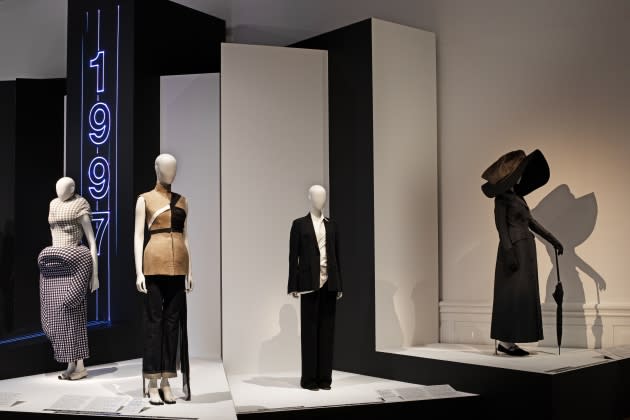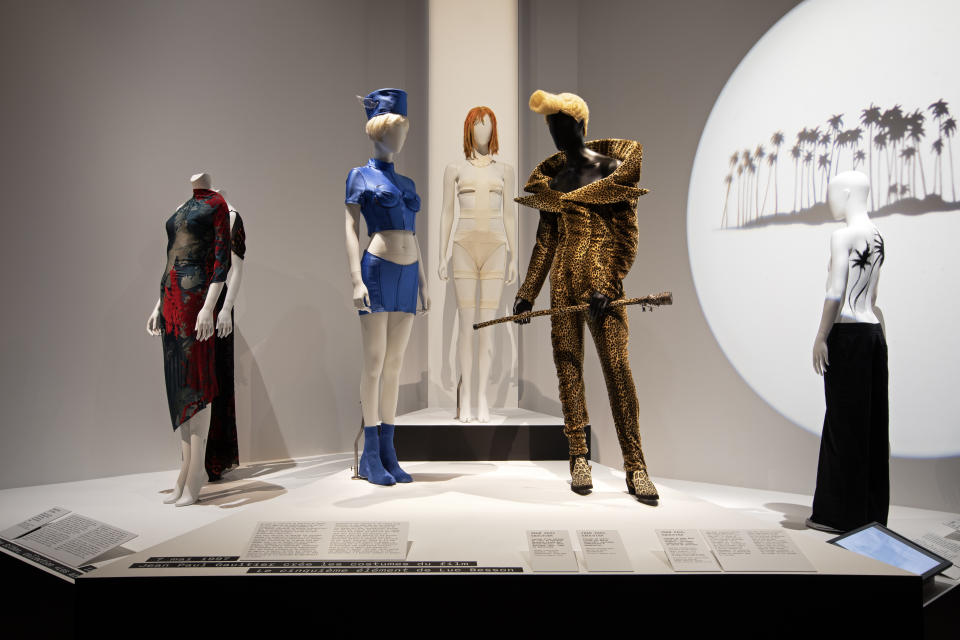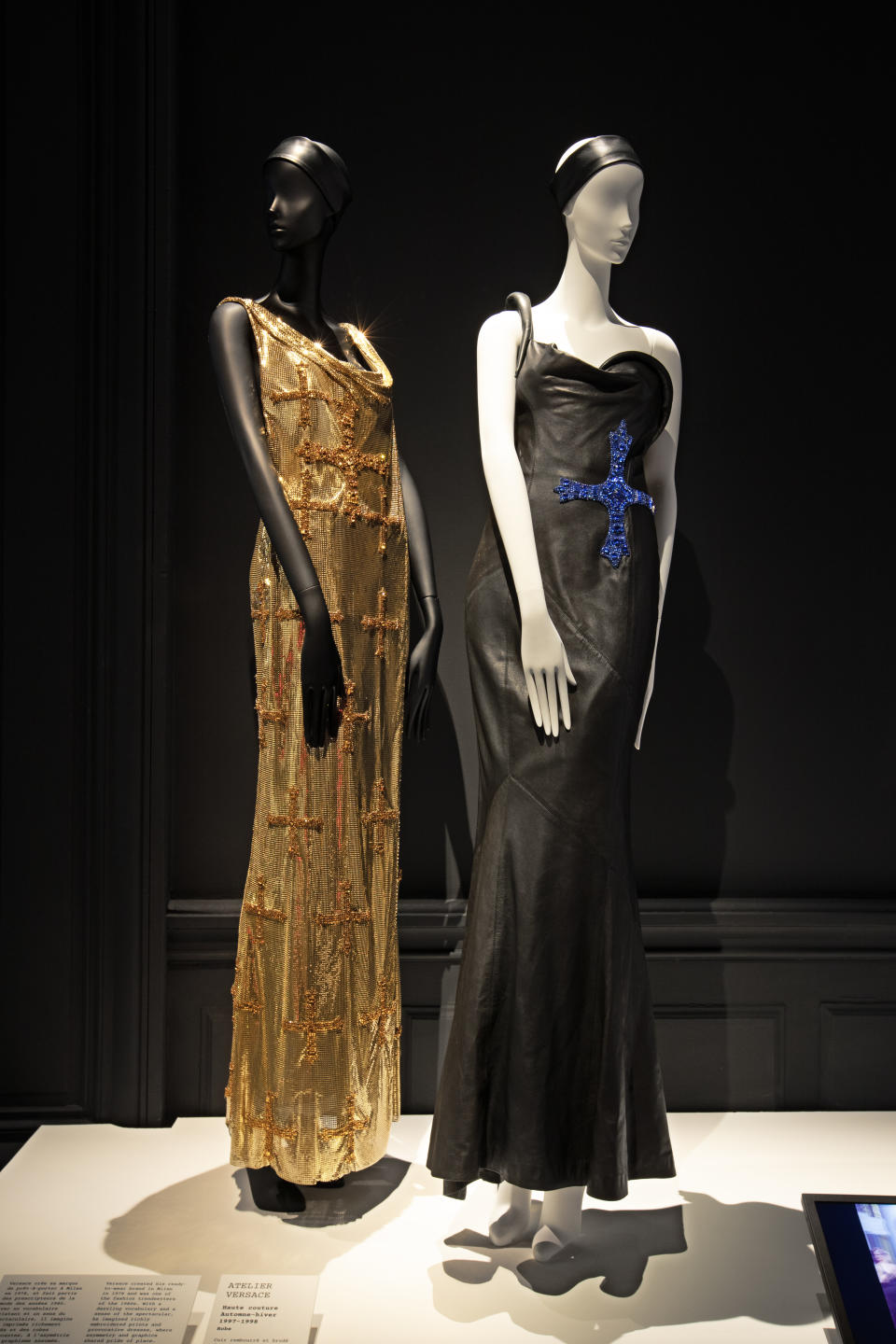Paris Exhibition Pinpoints 1997 as Contemporary Fashion’s Big Bang Moment
- Oops!Something went wrong.Please try again later.
- Oops!Something went wrong.Please try again later.
- Oops!Something went wrong.Please try again later.

PARIS — A new exhibition in Paris pinpoints the Big Bang moment of 21st-century fashion, retracing the chronology of a year considered at once the high point of the ’90s and the “gateway to the new millennium.”
“1997 Fashion Big Bang,” which opened Tuesday at the Palais Galliera, explores the time frame between the spring 1997 collections shown in October 1996 and October 1997 through the prism of silhouettes that marked the rise of a whole new generation of designers in ready-to-wear and couture, the opening of Colette, the deaths of Gianni Versace and Princess Diana — and the upending of the fashion calendar.
More from WWD
'The Love of Couture: Artisanship in Fashion Beyond Time' Exhibition at K11 Musea
Paris Exhibition Explores How Frida Kahlo Constructed Her Identity Through Clothing
A Look at 'Fashioning America: Grit to Glamour' Exhibition to Bow in Bentonville
The show, which runs until July 16, features some 100 exhibits, including more than 50 silhouettes from the museum’s permanent collections or loans from institutions, brands and private collectors, alongside accessories, photographs, archival documents and even a blue first-generation iMac G3.
“It’s a pivotal year because 1997 is where were born the references that are still relevant today, those collections that are top of mind and even designs that are still worn or are making a comeback,” said Alexandre Samson, curator of the exhibition and head of collections, haute couture from 1947 and contemporary creation.
Opening the exhibition is a G-string from Tom Ford’s spring 1997 collection at Gucci. It symbolized how “an American [designer] with a marketing vision” had initiated the shake-up of a still-staid European landscape, Samson said.
It was a time where Paris’ star seemed like it was fading. Couture was a dying art that press found boring. Alexander McQueen, Marc Jacobs and Ford at Gucci had contributed to rising the profile of London, New York and Milan as fashion capitals.
As a result, designers in Paris “had to react to their time and context,” continued the curator. And they had another reason to bring out their A-game that year.
“In July 1996, when Gianfranco Ferré announced his departure [from Dior,] there was such a never-seen-before frenzy, an excitement that designers were even applying for the job in the press,” Samson said.
“That’s also a context that struck Bernard Arnault, a key figure for fashion,” he continued. LVMH Moët Hennessy Louis Vuitton was then only 10 and the businessman successively named McQueen at Givenchy and John Galliano at Christian Dior in October 1996, followed by Marc Jacobs at Louis Vuitton in January 1997.
The exhibition, in the ground floor Salon d’Honneur and three galleries on the garden side of the museum, is arranged in a sunburst pattern that seems to originate from a monumental “1997” projected by laser beams and visible from the entrance, in a nod to the shockwave that year sent out.
A number of designs shown that October went on to become reference points, starting with a dress from Rei Kawakubo’s “Body Meets Dress, Dress Meets Body” collection “that still comes to mind when you want to explain Comme des Garçons,” Samson said.
Its neighbors are one of Martin Margiela’s “Stockman” waistcoats and trousers; a Yohji Yamamoto coat and hat that had garnered a standing ovation and rave reviews, and a softly tailored suit from Belgian designer Ann Demeulemeester. Inspired by her idol Patti Smith, whom she’d met the summer before, it put her on the map in the U.S. and triggered comparisons to Giorgio Armani, Samson said.
In the Grande Galerie, the haute couture collections that came the following January take pride of place: McQueen’s first and coolly received mythology-inflected effort at Givenchy; the first Jean Paul Gaultier couture show, a surprisingly classical offering coming from the so-called “enfant terrible” of ’80s ready-to-wear; Galliano’s Dior debut, which cemented him as a cornerstone of couture, and Thierry Mugler’s “Insectes” collection, his second couture outing.

It was a year of firsts, with the debuts of Alber Elbaz at Guy Laroche, Martine Sitbon, Raf Simons, Hedi Slimane at Saint Laurent Rive Gauche, Olivier Theyskens, Stella McCartney at Chloé where she’d also brought her friend Phoebe Philo to assist her, and a French designer on a six-month trial contract at Balenciaga: Nicolas Ghesquière.
Retail also changed. When Colette Rousseaux and daughter Sarah Andelman opened Colette in March 1997 at 213 Rue Saint-Honoré, “there was no interesting commercial proposal in the mid-1990s,” Samson said. “[Colette] is going to bring about the ‘concept store’ thanks to selections that juxtapose Reebok Fury sneakers next to Alexander McQueen, Emilio Pucci next to an iMac. And [Andelman] is also going to support emerging designers like Jeremy Scott,” Samson said.
For all the effervescence, there was also a dark side to the year. The death by overdose of 20-year-old Italian photographer Davide Sorrenti highlighted substance abuse. In the aftermath, his mother and then-U.S. president Bill Clinton demanded that the industry clean up its act.
And of course, that summer saw the murder of Gianni Versace in Miami only days after his last haute couture show in Paris, and the death of Princess Diana in a Parisian underpass. Her funeral saw Elton John, Donatella Versace and Arnault seated in the pews alongside politicians, heads of states and British and European royals.

Samson also highlights moments that cemented fashion as an integral part of pop culture, like the Gaultier-designed wardrobe for Luc Besson’s sci-fi epic “The Fifth Element”; Walter van Beirendonck’s body-building six-pack T-shirt for Bono that made it into an episode of “The Simpsons”; and Björk, who brought together the adornments of multiple cultures with a kimono-inspired McQueen dress for the striking cover of her “Homogenic” album.
Kawakubo’s costumes for “Scenario,” a ballet by Merce Cunningham, put the Japanese designer on par with artists like Marcel Duchamp and Andy Warhol who had collaborated with the choreographer.
There is one final shift that the exhibition highlights. After signaling his intention of moving to New York by using Robert Mapplethorpe’s “American Flags” photograph in communications, Helmut Lang showed his final collection in Paris that year. “It’s perceived as a slap in the face by the French fashion federation at the time, because people came to Paris, they didn’t leave,” Samson said.
What’s more, Lang went on to show at the beginning of September, in a move that was followed by a sizeable contingent. “That’s how we ended up with the Fashion Month calendar as we know it,” Samson said.
Best of WWD

